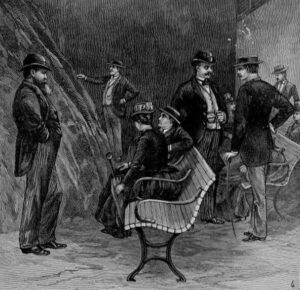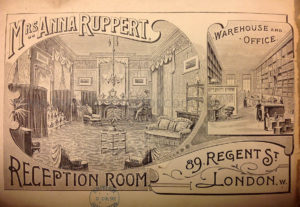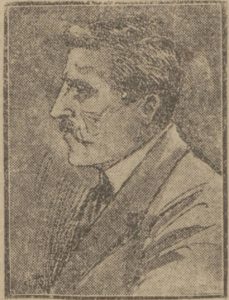.
Source: The Penny Illustrated Paper and Illustrated Times, 31 December 1892
.
I’ve decided to have a go at doing a podcast. It’s about 13 mins long and goes into much more detail than the post below, so if you’ve got time, do have a listen. If for some reason you desperately want to download it, you can do so here by right-clicking on the player thingy.
.
The Electric Corset was sold by Cornelius Bennett Harness, proprietor of the Ammoniaphone. His Medical Battery Company’s main product was the ‘electropathic’ belt, which contained zinc and copper plates that were somehow supposed to generate a health-giving current.
The Electric Corset was magnetic rather than electric, because all it had was a magnetised steel busk (the plates at the front that attach together to fasten the corset). Harness was initially a distributor for the famous American invention, Dr Scott’s Electric Corset (which Lidian at The Virtual Dime Museum has blogged about here). By 1891, however, he was selling his own version out of his opulent premises in Oxford Street.

A supposed visitor to this ‘Electropathic and Zander Institute’ described it as follows:
It seemed to me that I was standing in a Temple of silence. Outside was the rush and roar of London life. Inside, all was calm and peaceful. The interior, in its blend of colours and graceful hangings, and its rich carpeting, reminds one of Oriental times. The attendants move so softly and speak so gently. Here and there, young women, in neat print dresses and caps, move gracefully about. You yourself feel hushed and awed, as if some magician were about to appear.
The excerpt is from the Pall Mall Gazette (August 5 1892), and continues in a gushing manner about the numerous diplomas on display in Mr Harness’s consulting room. Although presented as a feature article, the piece turns out to be an advert, and was an attempt to cover up the fact that the company was in trouble.
Earlier that year, a customer named Mr Jeffrey had consulted the company’s hernia specialist (a former salesman of Oriental furniture). He was prescribed an electropathic belt but later consulted a doctor and got fitted with a proper truss. He refused to pay the balance of £3 3s. on the useless belt. In July 1892 the company sued him but lost, and had to give back the £2 2s. he had already paid. Harness had occasionally got into similar situations over the past few years, but this was really the start of a slippery slope for his electropathic empire.
In reporting the case, the Electrical Review described Harness’s activities as ‘one of the grossest cases of misrepresentation of the present day.’
In response, Harness sent a circular to newsagents warning them that he would hold them responsible for these ‘malicious libels’ should they continue to sell the Electrical Review. Many, including W.H. Smith & Co., did stop selling it, so the periodical’s owners took Harness to court and were granted damages of £1000.
In October 1893, the Pall Mall Gazette stopped accepting advertisements from the Medical Battery Company and printed a series of articles headed ‘The Harness “Electropathic” Swindle’, which stated:
The Medical Battery Company has for years past been fattening on a system of fraud and imposture which is absolutely unequalled in the annals of swindling.
Harness himself (pictured below) it described as:
… a man of no pretensions whatever to scientific or medical knowledge, but [is] a common, illiterate and unscrupulous charlatan.’
The articles resulted in a lot of customers demanding their money back. In early November 1893, he and his business associate, Dr James McCully (originally a qualified physician but struck off the Medical Register), were arrested and charged with unlawfully conspiring to defraud.
Dr McCully was found not guilty but the jury couldn’t agree about Harness. The courts ordered that the company be wound up. Almost immediately, Harness tried to resurrect it as the Medical Electrical Institute and was allowed to do so on condition that it was under control of a qualified medic. The creditors and shareholders of the old company unanimously agreed that it should go ahead, and Mr Harness became manager of the new company on a salary of £600 a year.
The trouble was that in spite of considerable advertising, no one would buy the products. Within a few months he went bust. After that, Harness faded into obscurity, dying in 1921 at Christchurch.





This web page was the inspiration for the book:”The Medical Electricians”.
See the link.
Thanks, Caro !